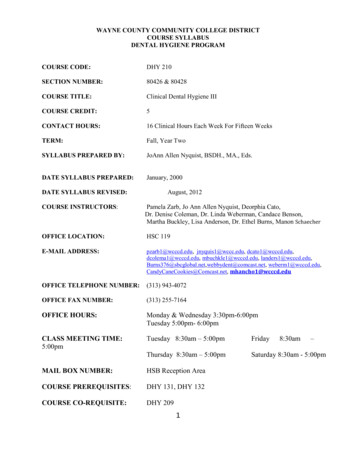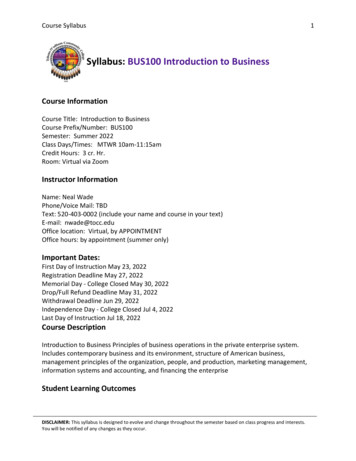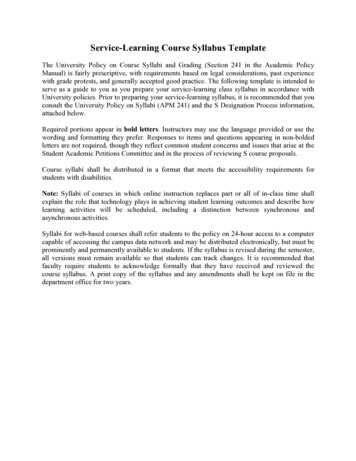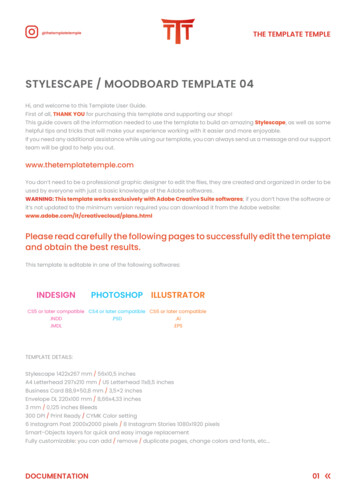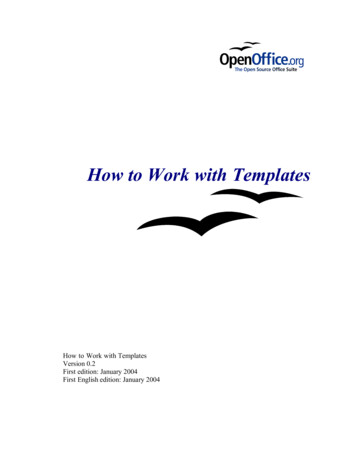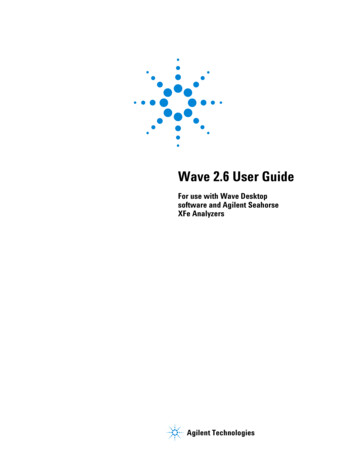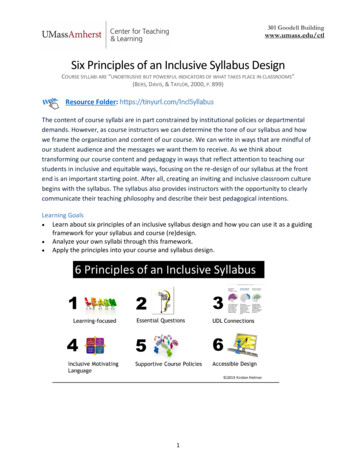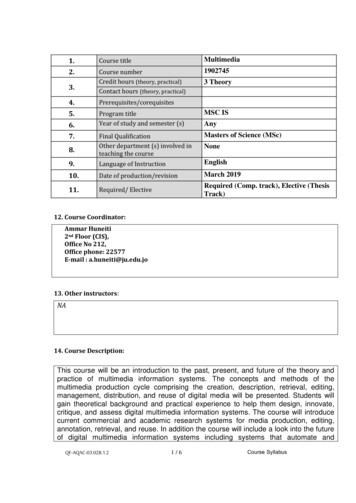
Transcription
1.Course titleMultimedia2.Course numberCredit hours (theory, practical)Contact hours (theory, practical)19027453.3 Theory4.Prerequisites/corequisites5.Program titleYear of study and semester (s)MSC ISFinal QualificationOther department (s) involved inteaching the courseMasters of Science (MSc)9.Language of InstructionEnglish10.Date of production/revisionMarch 201911.Required/ ElectiveRequired (Comp. track), Elective (ThesisTrack)6.7.8.AnyNone12. Course Coordinator:Ammar Huneiti2nd Floor (CIS),Office No 212,Office phone: 22577E-mail : a.huneiti@ju.edu.jo13. Other instructors:NA14. Course Description:This course will be an introduction to the past, present, and future of the theory andpractice of multimedia information systems. The concepts and methods of themultimedia production cycle comprising the creation, description, retrieval, editing,management, distribution, and reuse of digital media will be presented. Students willgain theoretical background and practical experience to help them design, innovate,critique, and assess digital multimedia information systems. The course will introducecurrent commercial and academic research systems for media production, editing,annotation, retrieval, and reuse. In addition the course will include a look into the futureof digital multimedia information systems including systems that automate andQF-AQAC-03.02B.1.21/6Course Syllabus
integrate many aspects of digital media production and reuse. A discussion of thedesign of next-generation multimedia information systems and prototypes is alsoincluded.In addition, This course is mainly designed to introduce the theoretical concepts ofdigital media including images, audio, animation and video. The difference betweenanalog and digital media is discussed. Different types of digital media are outlined andtheir digital storage process is explained in detail. The digital media encoding anddecoding concepts are explained. In addition, different types of digital mediacompression techniques are introduced. The most popular file formats are outlined foreach media type. Finally, the Multimedia related hardware, software, and web-relatedissues are discussed where necessary.Objectives of the course and Competency coverage:- This course aims to develop the students’ ability to understand multimediaconcepts, tools and applications.- Develop the students' skills of using multimedia tools and techniques.,- Introduce approaches and models for multimedia techniques and applications- Highlight and integrate image processing and compression techniquesAfter completing this course the student should be able to:- Understand multimedia techniques and applications- Understand Multimedia components (Text, image, audio and video) principles.- Understand and use compression technique in different multimedia components.QF-AQAC-03.02B.1.22/6Course Syllabus
1. Course aims and outcomes:Aims:-Understand the theoretical concepts of digital media including images, audio, animation andvideo.Understand the difference between analog and digital media.Understand digital media storage processUnderstand the digital media encoding and decoding conceptsUnderstand the different types of digital media compression techniquesOutline the most popular file formats for each media typeUnderstand the Multimedia related hardware, software, and web-related issuesIntended Learning Outcomes (ILOs): Upon successful completion of this course studentswill be able to:A- Knowledge and Understanding: Students should A1) Understand how multimedia titles are digitally encoded, compressed and their developmentprocess.A2) Know the different types of skills required to make multimedia titles both digital and analog.A3) Understand the basic principles for creating different types of multimedia elements includingImages, audio, animation and video.A4) Know about different types of hardware and software tools used for developing multimedia.B- Intellectual skills: with the ability to :B1) Distinguish between the tasks of different multimedia encoding techniquesB2) Distinguish between Different multimedia types in terms of their storage, presentation andapplication.B3) Use production software tools to produce primitive multimedia elementsB4) Use authoring software tools to produce a multimedia titleC- Subject specific skills – with ability to :C1) Fix different digital media problems.C2) Choose between different colouring scheme for a multimedia projectC3) Advise on the most suitable hardware for a multimedia projectC4) Create professional images, audios, and videosC5) Compute the file sizes of different multimedia elements and the capability to trade-off betweenmedia quality and available computer resourcesD- Transferable skills – with ability to:D1) Plan for a multimedia project including the needed skill setD2) Advise on different specifications of digital media standards.D3) Build professional multimedia titlesD4) Build the capability to trade-off between media quality and available computer resources.15. Topic Outline and Schedule:DurationChapter(Week)#Topics1Introduction to Multimedia11 (Ref 1) 1 (Ref 2)3Graphics and Image Representations22 (Ref 1) 3 (Ref 2)4Color in Image and Video12,3 (Ref 1) 4 (Ref 2)QF-AQAC-03.02B.1.23/6Course Syllabus
54 (Ref 1) 5 (Ref 2)Digitised Audio2Mid-Term Exam16Digital Video26 (Ref 1) 6 (Ref 2)7MIDI Audio14 (Ref 1) 5 (Ref 2)8Loss and Lossless Compression Techniques17 (Ref 1) 7, 8 (Ref 2)9Image Compression Technique (JPEG)13 (Ref 1), 9 (Ref 2)10Video and Audio Compression Techniques211Research Evaluation17 (Ref 1) 10 (Ref 2) 4 (Ref 4)5 (Ref 1) 13 (Ref 2) 4 (Ref 4)Final Exam116. Evaluation Methods and Course Requirements (Optional):Development of ILOs is promoted through the following teaching and learning methods:Lectures andDiscussionsDemonstrationA1, A2, A3, A4, B1, B2, C2, C3, C4, C5, D1, D2,D3, D4B1, B2, B3, B4, C1, C2, C3, C4, C5, D1, D2, D3,D4Grading:The total grades of this course are assigned as follows:Middle term exam30%Research, Assignments, Class presentation, Project 30%Final Exam40%17. Course Policies:، االمتناع المدبر عن حضور المحاضرات أو الدروس أو عن األعمال االخرى التي تقضي األنظمة بالمواظبة عليها . وكل تحريض على هذا االمتناع سوف يؤدي الى حرمان الطالب من المادة المعنية لن يكون هناك امتحان تعويضي اال في حالة وجود عذر وحالة Mid Term في حالة التغيب عن امتحان ال , على الطالب ابراز العذر لمدرس المادة في فتره ال تتجاوز الثالثة ايام من تاريخ االمتحان . طارئة من المستشفى . وحسب التعليمات , وللمدرس الحق في قبول او رفض العذر Concerns or complaints should be expressed in the first instance to the modulelecturer; if no resolution is forthcoming then the issue should be brought to theattention of the module coordinator (for multiple sections) who will take the concernsto the module representative meeting. Thereafter problems are dealt with by theDepartment Chair and if still unresolved the Dean and then ultimately the VicePresident. For the final complaints, there will be a committee to review grading thefinal exam. For more details on University regulations please visit egulations/Forms/Rules.aspx Intended Grading Scale:0-49 F,D- 50-62 D,D 63-73 C-,C,C 74-83 B-,B,B 84-100 A-,AQF-AQAC-03.02B.1.24/6Course Syllabus
Statement on Students with disabilitiesStudents with Disabilities: Students with disabilities who need special accommodations for this class areencouraged to meet with the instructor and/or their academic advisor as soon as possible. In order toreceive accommodations for academic work in this course, students must inform the course instructorand/or their academic advisor, preferably in a written format, about their needs no later than the 4th weekof classes.18. Required equipment: Laptop DataShow MM Software: Adobe Flash, MovieMaker, Sound Recorder, Adobe PhotoShop, Paint Bruch,Power Point.19. References:1.2.3.4. The main text books for this course are:The Science of Digital Media, J. Burg, Prentice Hall, 2009.Fundamentals of Multimedia, Li and Drew, Pearson Prentice Hall, 2004.Multimedia: Making it work, Tay Vaughan, 7th ed., McGraw Hill, 2008.Multimedia communications, applications, networks, protocols and standards", FredHalsall, Pearson Education,2001 Other reading material:1. Multimedia: Computing, Communications and Applications, materiRalfSteinmetz and Klara Nahrstedt, Prentice-Hall Inc.,20012. Multimedia Communication Systems: Techniques, Standards, and Networks,K.R Rao,Z .S. Bojkovic and D.A. Milovanovic, Prentice Hall of India,20023. Networked Multimedia Systems-Concepts, Architecture and design,Raghavan S V and Tripatti S K , Prentice hall, 1998 Journals:1. ACM Proceedings on Multimedia Computing, Communications, and Applications(TOMCCAP)2. IEEE Transactions on Multimedia3. IEEE Multimedia Magazine20. Additional information:Please Note: the course outline and other learning resources are also available on theUniversity E-Learning system (elearning.ju.edu.jo). Login using your account name andpassword given by the registration unit.QF-AQAC-03.02B.1.25/6Course Syllabus
Date: - 20.03.2019Name of Course Coordinator: Dr. Ammar Huneiti Signature:Head of curriculum committee/Department: ------------------------- Signature: --------------Head of Department: ------------------------- Signature: --------------------------------Head of curriculum committee/Faculty: ------------------------- Signature: ---------------------Dean: ------------------------------------------- -Signature: ---------------------------------Copy to:Head of DepartmentAssistant Dean for Quality AssuranceCourse FileQF-AQAC-03.02B.1.26/6Course Syllabus
QF-AQAC-03.02B.1.2 2 / 6 Course Syllabus integrate many aspects of digital media production and reuse. A discussion of the design of next-generation multimedia information systems and prototypes is also included. In addition, This course is mainly designed to introduce the theoretical concepts of





